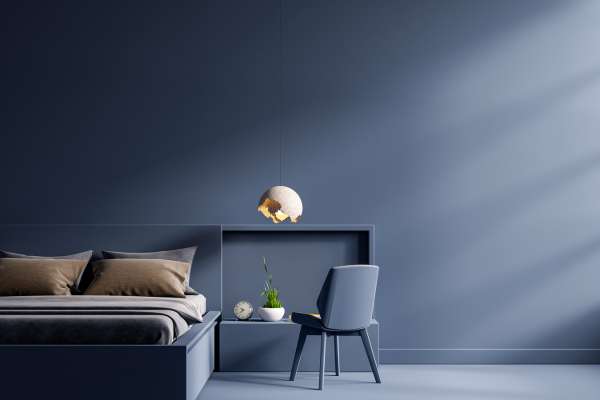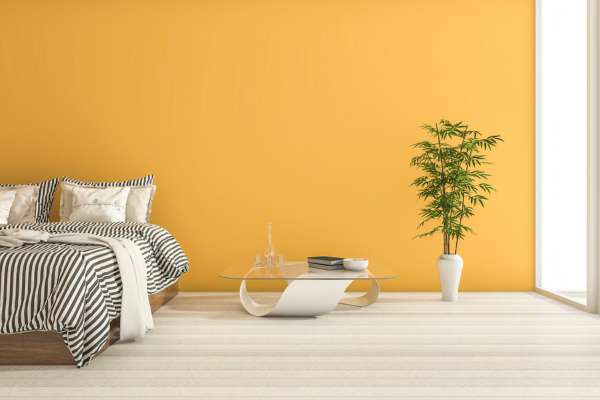In the realm of interior design, Small Bedroom Paint Ideas play a pivotal role in crafting spaces that are not only visually appealing but also highly functional. A well-conceived color palette can transform a compact bedroom into a welcoming haven, optimizing every inch for both aesthetics and utility. This outline will delve into the significance of color selection, the psychology behind it, and practical strategies for enhancing small bedrooms. By the end, you’ll have the tools to make your small bedroom a true masterpiece of design.
What to consider when choosing paint colors for a small bedroom
Light reflectance
Light reflectance is a measure of how much light a surface reflects. Lighter colors have a higher light reflectance value than darker colors. This means that lighter colors will make a room feel brighter and more open. Darker colors, On the other hand, Will absorb more light and make a room feel smaller and more closed-in.
When choosing paint colors for a small bedroom, It’s important to consider the light reflectance value of the colors you’re considering. If your bedroom doesn’t have a lot of natural light, you’ll want to choose a light color with a high light reflectance value. This will help to brighten up the space and make it feel larger.
Color temperature
Color temperature refers to the warmth or coolness of a color. Warm colors, such as red, orange, And yellow, can make a space feel cozy and inviting. Cool colors, such as blue, green, And purple, can make a space feel more open and airy.
When choosing paint colors for a small bedroom, it’s generally best to choose cool colors. This will help to make the space feel larger and more open. However, If you want to create a more cozy and inviting space, you can use warm colors on one or two accent walls.
Color scheme
A color scheme is a group of colors that are used together to create a harmonious and coordinated look. When choosing paint colors for a small bedroom, It’s important to choose a color scheme that will make the space feel larger and more open.
One simple way to create a cohesive color scheme is to use a monochromatic color scheme. This means using different shades of the same color. For example, You could use a light blue on the walls, A medium blue on the furniture, And a dark blue on the accent wall.
Best paint colors for small bedrooms
Light Colors

Light colors are the best choice for small bedrooms because they reflect light and make the space feel larger and brighter. White and off-white are classic and versatile options that can be used to create a variety of different looks. Other light colors that are well-suited for small bedrooms include pale blue, Soft green, light gray, lavender, And pale yellow.
White

White is the most popular paint color for small bedrooms because it reflects the most light. This can make a small bedroom feel larger and more open. White is also a versatile color that can be used to create a variety of different looks, from minimalist to traditional.
Off-white

Off-white is a slightly warmer version of white. It is a good choice for small bedrooms because it reflects light and makes the space feel larger, But it also adds a touch of softness and sophistication. Off-white can be used to create a more inviting and relaxing space.
Pale blue

Pale blue is a calming and relaxing color that is well-suited for small bedrooms. It can help to create a sense of peace and tranquility in the space. Pale blue can be paired with other light colors, Such as white or off-white, To create a bright and airy look.
Soft green

Soft green is another calming and relaxing color that is well-suited for small bedrooms. It can help to create a sense of connection to nature in space. Soft green can be paired with other light colors, such as white or off-white, to create a fresh and invigorating look.
Light gray

Light gray is a versatile color that can be used to create a variety of different looks in a small bedroom. It can be used to create a minimalist look, a traditional look, or a modern look. Light gray can be paired with other light colors, such as white or off-white, to create a bright and airy look.
Lavender

Lavender is a soft and romantic color that is well-suited for small bedrooms. It can help to create a calming and relaxing atmosphere in the space. Lavender can be paired with other light colors, such as white or off-white, to create a feminine and elegant look.
Pale yellow

Pale yellow is a cheerful and sunny color that is well-suited for small bedrooms. It can help to brighten up the space and make it feel more inviting. Pale yellow can be paired with other light colors, such as white or off-white, to create a classic and timeless look.
Choosing the Right Colors

Consider Light and Neutral Tones
Light colors: Lighter colors reflect more light, making a small bedroom feel more open and airy. Popular light colors for small bedrooms include white, off-white, pale blue, soft green, and light gray.
Neutral tones: Neutral tones, such as beige, cream, and taupe, are also good choices for small bedrooms because they are versatile and can be used to create a variety of different looks. Neutral tones can also be paired with accent colors to add interest to the space.
Accent Colors for Depth and Interest
Selecting complementary accent colors: Accent colors can be used to add depth and interest to a small bedroom. When choosing accent colors, it is important to select colors that are complementary to the main wall color. For example, if the main wall color is light blue, you could use complementary accent colors such as white, yellow, or orange.
Using accent colors sparingly for impact: Accent colors should be used sparingly for impact. Too many accent colors can make a small bedroom feel cluttered and overwhelming. Instead, focus on using a few key accent colors to create a harmonious and inviting space.
Small Bedroom Furniture and Paint
Coordinating with Furniture Colors
Coordinating paint colors with furniture is essential for achieving a harmonious and visually appealing space. Two key considerations come into play here: matching or contrasting with furniture and harmonizing color schemes for a unified look. Matching paint colors with furniture can create a sense of cohesion and elegance, making the room appear well-organized.
On the other hand, contrasting colors can add depth and interest, making furniture pieces stand out as focal points. To achieve a unified look, it’s crucial to consider the overall color scheme of the room. Whether you opt for matching or contrasting, a well-thought-out color scheme will tie the elements together, resulting in a balanced and stylish interior.
Space-saving Furniture Solutions
In today’s compact living environments, space-saving furniture solutions have become paramount for maximizing functionality and aesthetics. Two key strategies in this endeavor are the incorporation of multi-functional furniture pieces and the implementation of clever storage solutions to reduce clutter. Multi-functional furniture serves a dual purpose, combining form and function seamlessly.
Items like sofa beds or extendable dining tables save space and offer versatility. Simultaneously, effective storage solutions, such as built-in shelves, hidden compartments, or wall-mounted units, help declutter living areas by maximizing vertical space. These thoughtful choices not only optimize room layout but also enhance the overall design, making small spaces more livable and aesthetically pleasing.
Tips for painting a small bedroom
Use a high-quality paint
Selecting high-quality paint is a fundamental step in achieving a professional and enduring paint job. The choice of superior paint ensures a smooth and even application, resulting in a seamless finish. Moreover, high-quality paint offers vibrant, long-lasting color, maintaining its brilliance over time. This investment not only enhances the visual appeal but also guarantees the durability of the painted surface, making it an essential choice for any painting project.
Prepare the walls properly
Properly preparing the walls is a critical foundation for a successful paint job. This meticulous process involves sanding down any rough spots and diligently filling in any holes or imperfections. By smoothing the surface and addressing flaws, you create an ideal canvas for paint application. This attention to detail not only ensures a more professional and polished outcome but also extends the longevity of the paint, preventing future issues. Proper wall preparation is a vital step in achieving a flawless and enduring finish in any painting project.
Use a primer
In the realm of professional painting, the use of a primer is an indispensable step. Primers play a pivotal role in improving paint adhesion to the walls, ensuring a stronger bond and enhancing the overall durability of the finish. Moreover, primers promote a more even application of paint, resulting in a smoother and more refined surface. This foundational step is instrumental in achieving a professional, long-lasting paint job, making it a non-negotiable component of any painting project.
Paint in natural light
Natural light offers the most accurate representation of the paint’s true color. This critical step allows you to make informed decisions about the shade, ensuring that the chosen color aligns with your vision and avoids any unexpected discrepancies once the paint dries. By assessing the paint in natural light, you can achieve the desired look and prevent unwelcome surprises, contributing to a professional and satisfying paint job.
Use painter’s tape to protect the edges of your walls
Achieving clean and precise lines in your painting project requires the strategic use of painter’s tape. This professional technique is essential for protecting the edges of your walls, ensuring that the paint remains confined to the intended areas. Painter’s tape not only prevents accidental smudges or paint bleed but also maintains the crisp and polished appearance of your work. It’s a small investment that yields significant benefits, contributing to a flawlessly executed paint job with sharp, well-defined edges.
Take your time and apply two thin coats of paint
Exercising patience and applying two thin coats of paint is a cornerstone of professional painting. Rushing the process can lead to uneven coverage, streaks, and a less-than-perfect finish. By taking your time and applying two thin coats, you allow each layer to dry properly, promoting a smoother and more consistent appearance. This method enhances the overall durability and aesthetic quality of the paint job. The investment of time ensures a professional, long-lasting result, making it a vital step in achieving a truly impeccable finish.
Allow the paint to dry completely before adding any furniture or decor
For a truly professional paint job, it’s essential to exercise patience and allow the paint to dry completely before introducing furniture or decor. Prematurely placing items in the freshly painted space can lead to smudges, scuffs, and imperfections in the finish. By giving the paint ample time to dry, you ensure a pristine, unblemished surface. This attention to detail not only preserves the quality of the paint job but also prevents the need for touch-ups or redoing the work, resulting in a polished and professional final look.
Lighting Considerations
Maximizing Natural Light
In the realm of interior design, maximizing natural light is a cornerstone of creating bright, inviting spaces. Two key strategies to achieve this are through window treatments that enhance the flow of natural light and the strategic use of mirrors. Window treatments, such as sheer curtains or blinds, can diffuse and soften incoming sunlight, creating a warm and welcoming ambiance.
Mirrors, on the other hand, are versatile tools that reflect light, infusing a room with brightness and the illusion of depth. These design elements work in synergy to optimize natural light, resulting in well-lit, airy, and visually appealing interiors that exude a professional and polished aesthetic.
Artificial Lighting and Paint
The interplay between artificial lighting and paint is a critical aspect of interior design. To professionally showcase paint colors, it’s essential to ensure proper lighting. The color and intensity of light can significantly impact how paint appears in a space. Selecting the right light fixtures is equally important for creating the desired ambiance.
Different fixtures, such as pendant lights, wall sconces, or recessed lighting, can cast various hues and shadows, affecting the overall atmosphere of a room. By carefully considering both lighting type and fixtures, you can achieve a professional and harmonious alignment between artificial lighting and paint, enhancing the visual appeal and functionality of any interior.
Read more : How Long Does It Take To Paint A Bedroom
Conclusion
Selecting the perfect paint colors for your small bedroom is a pivotal decision, as it can truly transform the ambiance of the space. By adhering to the guidelines provided, you have the opportunity to craft a bedroom that seamlessly combines style and comfort, ensuring it becomes a stylish, inviting retreat that perfectly reflects your personal taste and preferences. Your careful color choices will have a lasting impact, making your small bedroom a haven of both aesthetics and warmth.
